Releasing safe and useful code for GOV.UK Verify

...opening up our code, and we’re looking forward to learning and developing our approach as we go along. If you have any feedback on the approach we’re planning to take,...

...opening up our code, and we’re looking forward to learning and developing our approach as we go along. If you have any feedback on the approach we’re planning to take,...

...app to generate a security code or to receive a security code on your landline phone, rather than waiting for a text to arrive, so you don’t need a mobile...

...The codebase for GOV.UK Verify is mainly java microservices at the backend. At the frontend we use Jade as our templating language. However, we’re currently rebuilding the frontend of the...

...step such as having a one-off code sent to your mobile phone or generating a code in an authentication app. Therefore, if your information is lost or compromised it will...
James Stewart has published a post about how GDS decides when it's ok not to publish source code. The identity assurance programme operates within the approach outlined by James. We...
...to using a SAML metadata file to retrieve public certificates. This has reduced complexity in our code and standardises the usage of SAML metadata in our application began upgrading to...

...published We made the first small step towards opening up our codebase this year when we published a small module of code. There is a lot more to come in...
...towards the end of last year. Reducing our technical debt There are things we need to do to the GOV.UK Verify codebase to tidy up accumulated impact of having made...

“Why doesn’t GOV.UK Verify work for me?”, “How can I be sure the verification process is secure?”, “Why is this app I’ve downloaded not working?”. These are some examples of...
...identity assurance for government services. This will enable departments, where appropriate, to offer users digital services that do not require a high level of identity assurance. Improving and maintaining GOV.UK...